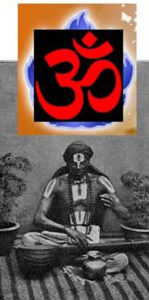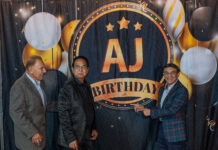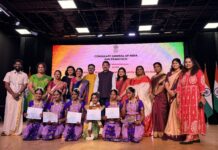
AURORA, Illinois: Recently, I had the pleasure of seeing one of the most informative plays on the evolution of Indian Classical music and dance performed beautifully at the Bharat Sevasram Sangha temple auditorium, in Aurora, Illinois.
At first glance, this temple looks more like an industrial warehouse from the outside than an Indian temple, but walking in you are transformed to the magical beauty of statues and portraits of Indian gods and Murtis of important deities from our religious roots
In the basement of the temple, there is a beautiful auditorium complete with lobby area, eating area, theater, audience seating, restrooms and direct entrance from the parking lot (including handicap ramp).
This auditorium and adjoining space includes a library and an Audio-Visual facility where the Temple conducts regular Youth Camp, Yoga sessions, Health clinics, Meditation and Spiritual lectures and classes.
The play starts with one of the temple Swamiji sitting in front of a completely darkened auditorium lighting a fire in the holy urn and performing Yagna (fire offering) by reciting mantras in Sanskrit from Vedas – written some ten thousand years ago.
Soon we hear Swamiji’s mantra recitation overlapped by recorded hymns chorus with a Tambura drone that transports the audience to thousands of years past in the Vedic ages. At the end of the chants we hear bells ringing, Mridnagam striking, and the Gayatri Mantra sung in beautiful harmony.
“Om Bhur Bhuva Swaha… Tat savitur Varanyam… Bhargo Devashya dhimahi… Dhiyo Yo Na prachodyaat…”
Translation – “Let us meditate in the glory of this earth, sky and the universe…Let us take in our hearts the revelation that we do not just belong to one particular place or land or planet…. but we are all an integral part of the universe…”
Simultaneously to the Gayatri Mantra recitation, an image of the universe with distant stars and planets and the dark infinite sky lights up the projection screen, an indication that the writers of these hymns not only addressed the earth and their immediate surroundings, but also included the entire universe in their poetry and imagination…
It was indeed a proper initiation to the extremely powerful hymns of the Vedas and the inclusiveness of their initial concepts and philosophies.
The 90-minute play was then broken into eight Acts which follow incrementally and chronologically explaining through the lucid narration how the Vedas formed the foundation Sanatan Dharma – or the Eternal Order – that ultimately was labeled as Hinduism.
Act 1 – Invocation – Vedic Chants and Gayatri Mantra
Act 2 – The Beginning – Who / How / Where / When Sanatan Dharma and the Four Vedas were created
Act 3 – Sama Veda – Reaching the supreme through prayers, music and dance – Grammar of Music
Act 4 – Ramayana – Concepts and fundamentals taught in Vedas are told through story of Rama, Ram Stuti.
Act 5 – Mahabharata – Complex conflicts of kinship, friendship, family loyalty and duty, Vastraharan.
Act 6 – Na?ya Sastra – complete encyclopedic compilation and texts on the performing arts, RASA theory
Act 7 – Film Music – How Classical Ragas influenced popular music – medley of music /dance on Raga Yaman
Act 8 – The Present – How metamorphosis for thousands of years, resulted in the Hindustani music of today
In addition to the narrated story of evolution of music synchronized with projected images, the play presented a mesmerizing dance by Madhura Sane, a classically trained based in Naperville with her own school of dancing – Nritya Natya Academy. The dance items were accentuated with fabulous costume and jewelry matching the period and the topic of the story. The dances were lit with professional lighting that enhanced the show in their own ways.
I can only describe the play as magical, with the impeccable research, narration and direction by Kushal Bose, the present (acting) President of the BSS Chicago Chapter, assisted by Tabla Maestro Subhasis Mukherjee, who also did the digital editing, mixing and special effects for the play. The mood, music, costume, dances, instruments, chants and props – everything complemented each other and delivered an unforgettable experience – one that has never been attempted by local artistes in the Chicago land area.
I encourage you to go see this production when it is re-staged in Chicago (hopefully) towards the end of the year. In the Chicago area, many organizations put on various shows and events, but I guarantee you won’t find one quite like the Eternal Prayer’s rendition of the evolution of Indian Classical music from the Vedic times to the present.
If you want to escape from the hustle and bustle of your daily life and plunge into an educational journey that brings one face to face with our roots and rich musical heritage into a magical experience in the city of Chicago itself, then come out and support these fine players!
Eternal Prayer has already been tentatively scheduled to perform all over the United States – Los Angeles (October), Washington DC and New Jersey (November), Houston (December) and Chicago (September).
To get more information about the show or to book this show at your facility or organization please contact the producer Kushal Bose at (630) 300 4228 or e-mail kushal@boseassciates.com.
Bharat Sevashram Sangha is a leading monastic institution of India, headquartered in Kolkatta. Founded in 1917 by the illustrious saint Yugacharya Sreemat Swami Pranavanandaji, the Sangha is a pioneer organization engaged in socio-cultural, educational activities and relief work during natural calamities. It has more than 300 branches in India, the United Kingdom, the United States, Canada, Trinidad and Guyana.
Contact: Swami Mukundananda, Resident Monk, BSS Temple, Aurora – (630) 301 6039






